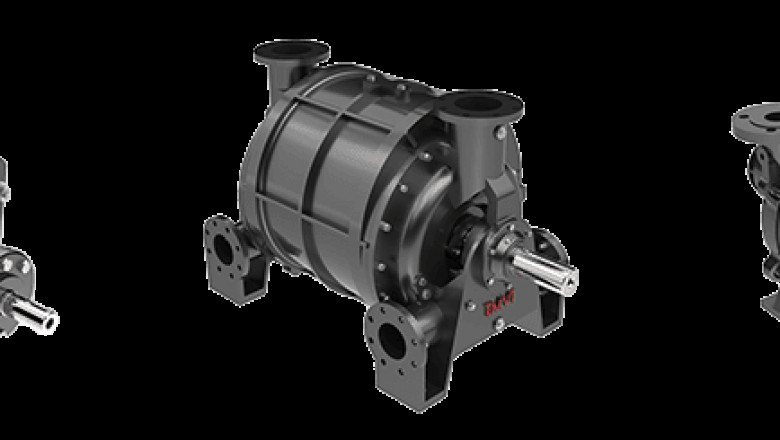views
How Temperature Affects the Performance of a Liquid Ring Vacuum Pump
Introduction
A Liquid Seal Vacuum Pump, commonly known as a Liquid Ring Vacuum Pump (LRVP), is a critical piece of equipment in various industries, including chemical processing, power generation, and pharmaceuticals. Its efficiency relies heavily on the sealing liquid, typically water, which creates the vacuum by forming a rotating ring inside the pump. However, one of the most significant factors influencing its performance is temperature. This article explores how temperature variations impact the efficiency, capacity, and longevity of a Liquid Ring Vacuum Pump, along with best practices to optimize its operation.
Understanding the Liquid Ring Vacuum Pump Mechanism
Before delving into temperature effects, it's essential to understand how a Liquid Seal Vacuum Pump works:
- The pump consists of an impeller rotating eccentrically within a cylindrical casing.
- A sealing liquid (usually water) is introduced, forming a rotating ring due to centrifugal force.
- As the impeller rotates, gas is trapped between the liquid ring and impeller vanes, compressing and discharging it.
The efficiency of this process depends on the viscosity, vapor pressure, and temperature of the sealing liquid.
Impact of Temperature on Pump Performance
A. Higher Temperature Effects
-
Reduced Vacuum Efficiency
-
As temperature increases, the sealing liquid (water) evaporates faster, reducing the pump's ability to maintain a stable vacuum.
-
Higher vapor pressure at elevated temperatures leads to more gas re-entrainment, lowering suction capacity.
-
Increased Power Consumption
-
Hotter sealing liquid requires more energy to maintain the same compression ratio, increasing operational costs.
-
Risk of Cavitation
-
High temperatures can cause cavitation—formation and collapse of vapor bubbles—damaging impeller blades and reducing pump life.
-
Seal Liquid Degradation
-
If using specialized fluids (e.g., oils or solvents), excessive heat can break them down, leading to contamination and reduced sealing efficiency.
B. Lower Temperature Effects
-
Improved Vacuum Levels
-
Cooler sealing liquid has lower vapor pressure, enhancing vacuum generation.
-
Higher Density & Better Sealing
-
Cold liquids are denser, improving the liquid ring's stability and sealing efficiency.
-
Risk of Freezing in Extreme Cases
-
If temperatures drop too low, the sealing liquid may freeze, causing mechanical failure.
Optimal Operating Temperature Range
For water-sealed Liquid Ring Vacuum Pumps, the ideal temperature range is 15°C to 25°C (59°F to 77°F). Beyond this range:
- Above 30°C (86°F): Efficiency drops, requiring cooling systems.
- Below 10°C (50°F): Risk of reduced flow or freezing if antifreeze isn’t used.
For non-water sealing liquids (oils, solvents), manufacturers provide specific temperature guidelines.
Mitigation Strategies for Temperature Fluctuations
A. Cooling Systems
-
Heat Exchangers: Maintain optimal liquid temperature by removing excess heat.
-
Chillers: Used in high-temperature environments to cool the sealing liquid.
B. Sealing Liquid Selection
-
Water: Most common but sensitive to temperature.
-
Oil/Solvents: Better for high-temperature applications but require monitoring.
-
Antifreeze Solutions: Prevent freezing in cold climates.
C. Pump Design Adjustments
-
Variable Speed Drives (VSDs): Adjust impeller speed based on temperature-induced load changes.
-
Enhanced Materials: Corrosion-resistant alloys for high-temperature operations.
D. Regular Maintenance
-
Monitor liquid temperature and quality.
-
Clean heat exchangers and cooling jackets to prevent efficiency loss.
Real-World Applications & Case Studies
A. Chemical Processing Plants
-
High-temperature vapors require efficient cooling to prevent pump failure.
-
Using glycol-based sealing liquids improves performance in hot conditions.
B. Power Generation Sector
-
Condenser vacuum systems rely on stable temperatures for optimal efficiency.
-
Overheating leads to turbine inefficiency and higher energy consumption.
C. Pharmaceutical Industry
-
Temperature-sensitive processes demand precise vacuum control.
-
Closed-loop cooling systems ensure consistent pump performance.
Conclusion
Temperature plays a critical role in the performance of a Liquid Seal Vacuum Pump. While higher temperatures reduce efficiency and increase wear, lower temperatures improve vacuum levels but risk freezing. By implementing cooling systems, proper sealing liquid selection, and regular maintenance, industries can optimize their Liquid Ring Vacuum Pump operations for maximum efficiency and longevity.














Comments
0 comment